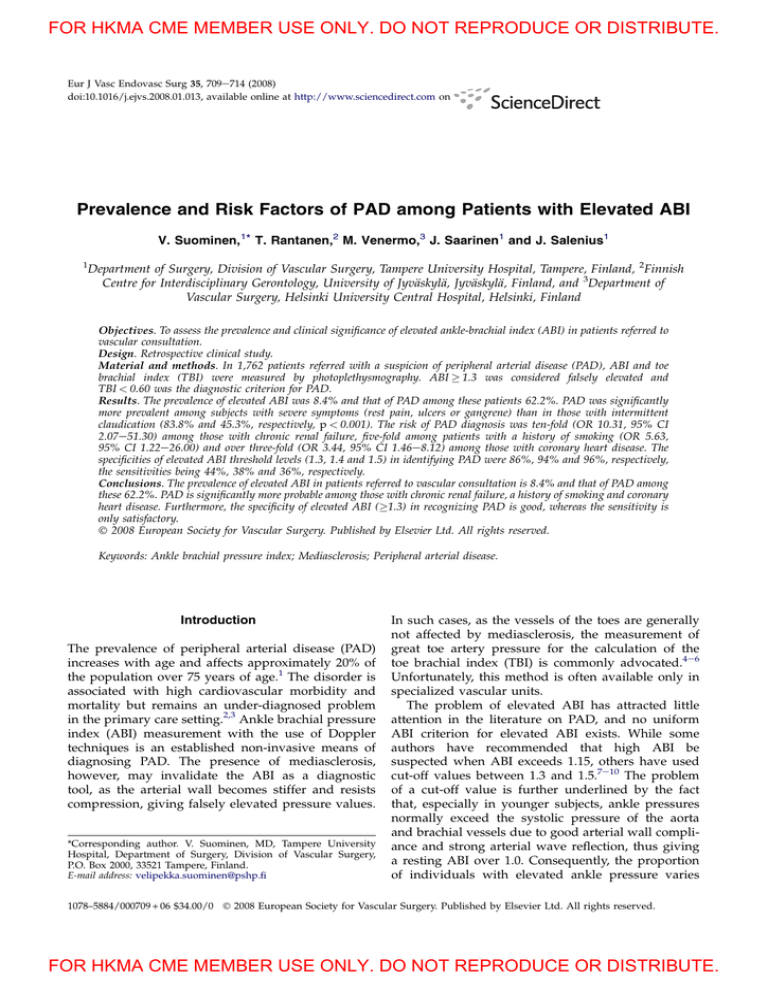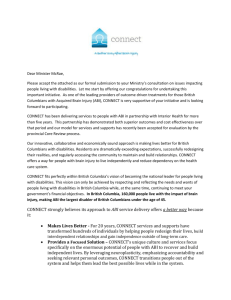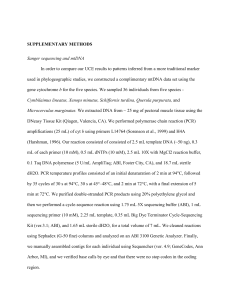for hkma cme member use only. do not reproduce or distribute. for
advertisement

FOR HKMA CME MEMBER USE ONLY. DO NOT REPRODUCE OR DISTRIBUTE. Eur J Vasc Endovasc Surg 35, 709e714 (2008) doi:10.1016/j.ejvs.2008.01.013, available online at http://www.sciencedirect.com on Prevalence and Risk Factors of PAD among Patients with Elevated ABI V. Suominen,1* T. Rantanen,2 M. Venermo,3 J. Saarinen1 and J. Salenius1 1 Department of Surgery, Division of Vascular Surgery, Tampere University Hospital, Tampere, Finland, 2Finnish Centre for Interdisciplinary Gerontology, University of Jyväskylä, Jyväskylä, Finland, and 3Department of Vascular Surgery, Helsinki University Central Hospital, Helsinki, Finland Objectives. To assess the prevalence and clinical significance of elevated ankle-brachial index (ABI) in patients referred to vascular consultation. Design. Retrospective clinical study. Material and methods. In 1,762 patients referred with a suspicion of peripheral arterial disease (PAD), ABI and toe brachial index (TBI) were measured by photoplethysmography. ABI 1.3 was considered falsely elevated and TBI < 0.60 was the diagnostic criterion for PAD. Results. The prevalence of elevated ABI was 8.4% and that of PAD among these patients 62.2%. PAD was significantly more prevalent among subjects with severe symptoms (rest pain, ulcers or gangrene) than in those with intermittent claudication (83.8% and 45.3%, respectively, p < 0.001). The risk of PAD diagnosis was ten-fold (OR 10.31, 95% CI 2.07e51.30) among those with chronic renal failure, five-fold among patients with a history of smoking (OR 5.63, 95% CI 1.22e26.00) and over three-fold (OR 3.44, 95% CI 1.46e8.12) among those with coronary heart disease. The specificities of elevated ABI threshold levels (1.3, 1.4 and 1.5) in identifying PAD were 86%, 94% and 96%, respectively, the sensitivities being 44%, 38% and 36%, respectively. Conclusions. The prevalence of elevated ABI in patients referred to vascular consultation is 8.4% and that of PAD among these 62.2%. PAD is significantly more probable among those with chronic renal failure, a history of smoking and coronary heart disease. Furthermore, the specificity of elevated ABI (1.3) in recognizing PAD is good, whereas the sensitivity is only satisfactory. Ó 2008 European Society for Vascular Surgery. Published by Elsevier Ltd. All rights reserved. Keywords: Ankle brachial pressure index; Mediasclerosis; Peripheral arterial disease. Introduction The prevalence of peripheral arterial disease (PAD) increases with age and affects approximately 20% of the population over 75 years of age.1 The disorder is associated with high cardiovascular morbidity and mortality but remains an under-diagnosed problem in the primary care setting.2,3 Ankle brachial pressure index (ABI) measurement with the use of Doppler techniques is an established non-invasive means of diagnosing PAD. The presence of mediasclerosis, however, may invalidate the ABI as a diagnostic tool, as the arterial wall becomes stiffer and resists compression, giving falsely elevated pressure values. *Corresponding author. V. Suominen, MD, Tampere University Hospital, Department of Surgery, Division of Vascular Surgery, P.O. Box 2000, 33521 Tampere, Finland. E-mail address: velipekka.suominen@pshp.fi In such cases, as the vessels of the toes are generally not affected by mediasclerosis, the measurement of great toe artery pressure for the calculation of the toe brachial index (TBI) is commonly advocated.4e6 Unfortunately, this method is often available only in specialized vascular units. The problem of elevated ABI has attracted little attention in the literature on PAD, and no uniform ABI criterion for elevated ABI exists. While some authors have recommended that high ABI be suspected when ABI exceeds 1.15, others have used cut-off values between 1.3 and 1.5.7e10 The problem of a cut-off value is further underlined by the fact that, especially in younger subjects, ankle pressures normally exceed the systolic pressure of the aorta and brachial vessels due to good arterial wall compliance and strong arterial wave reflection, thus giving a resting ABI over 1.0. Consequently, the proportion of individuals with elevated ankle pressure varies 1078–5884/000709 + 06 $34.00/0 Ó 2008 European Society for Vascular Surgery. Published by Elsevier Ltd. All rights reserved. FOR HKMA CME MEMBER USE ONLY. DO NOT REPRODUCE OR DISTRIBUTE. FOR HKMA CME MEMBER USE ONLY. DO NOT REPRODUCE OR DISTRIBUTE. 710 V. Suominen et al. between studies and its true prevalence remains obscure. Moreover, the clinical significance of elevated ABI is not as clear as that of low ABI. However, an association between high ABI and total and cardiovascular mortality similar to that of low ABI was found in two recently published studies.11,12 The present aims were (1) to establish the prevalence of elevated ankle brachial index among patients admitted to the university hospital vascular outpatient clinic for evaluation purposes; (2) to describe the prevalence and risk factors of PAD among those with elevated ABI; and (3) to assess the specificities and sensitivities of different levels of elevated ABI in identifying PAD. Material and Methods Study population This is a retrospective analysis of consecutive patients referred to the vascular outpatient clinic at Tampere University Hospital (TAUH), Finland, between April 2002 and January 2006. Patients with suspected lower extremity arterial insufficiency were included in the study. The reasons for referral were categorized as (1) intermittent claudication, (2) rest pain, ulcer or gangrene, (3) suspected combined arterial and venous disease and (4) non-specified indication (coldness, numbness). TAUH serves a region with roughly 470,000 inhabitants, and all vascular surgical consultations, diagnostics and procedures are carried out exclusively at TAUH. Patients are referred to the outpatient clinic not only from the municipal health centres but also from regional cardiac, renal and other units located within the TAUH district. Every patient visit to the hospital is recorded in the central register with the diagnosis and reason for attendance. The purpose of the present study was to measure the ankle brachial index (ABI) and toe brachial index (TBI) of all new admissions (N ¼ 2,237) during the study period. The pressure measurements were unsuccessful in 51 cases (2.3%). Cases with successful measurements and with no prior lower extremity vascular procedures (N ¼ 1,762, 78.8%) were subjected to further analysis. Risk factors for PAD and other co-morbid diseases Data from the patients’ files were collected systematically by one examiner (VS). Case records provided information on age, sex, cardiovascular risk factors (diabetes mellitus, hyperlipidaemia, hypertension, smoking within 5 years), cardiovascular diseases other than PAD (coronary heart disease [CHD], cerebrovascular disease), respiratory disease, chronic renal failure and systemic corticosteroid treatment in addition to stored images. The diagnosis for each disease was considered positive if it had been previously established at TAUH or mentioned in the referral, or if the patient was on appropriate medication. No distinction was made between chronic renal failure and ESRD. Measurement of ABI/TBI and definitions ABI and TBI were measured using the Nicolet VasoGuard (Nicolet Vascular Inc, Madison, WI), a device that allows simultaneous systolic blood pressure measurements from upper and lower extremities by means of photoplethysmography. Measurements were carried out in optimal conditions (supine position, room temperature, after resting for ten minutes) by trained vascular nurses. Photoplehysmographic probes were attached to the tips of the big toes, and cuffs were placed on the arms and legs above the ankle or at the base of the big toes. The higher of the two simultaneously measured brachial systolic blood pressure values was used in the analysis. As a rule, values obtained from single ABI or TBI measurements of good quality were used. ABI 0.9 was considered low, ABI > 0.9 or < 1.3 normal and ABI 1.3 falsely elevated. Patients with an ABI 0.9 and/or TBI < 0.60 in either leg were regarded as presenting with PAD. Patients with an ABI 1.3 in both legs or in one leg, in which case the other side had to be normal, were categorized as belonging to the elevated ABI group. The calculations of the sensitivity and specificity of different ABI threshold levels (1.3, 1.4, 1.5) in identifying PAD were based on the results of ABI and TBI measurements. Review of the angiograms For 69 patients with an elevated ankle brachial index (N ¼ 148), a digital subtraction angiography (DSA) had been performed after the initial consultation. In one patient the TBI was >0.60, while the rest had a TBI < 0.60, i.e. PAD. The angiography images were reviewed for the presence of PAD, defined as a more than 50% narrowing of the arterial lumen in any arterial segment of the lower extremities. Statistical analysis SPSS 15.0 for windows was used for statistical analysis (SPSS, Chicago, IL, USA). For discrete variables, Eur J Vasc Endovasc Surg Vol 35, June 2008 FOR HKMA CME MEMBER USE ONLY. DO NOT REPRODUCE OR DISTRIBUTE. FOR HKMA CME MEMBER USE ONLY. DO NOT REPRODUCE OR DISTRIBUTE. 711 PAD among Patients with Elevated ABI analyses were made with the aid of cross-tabulations combined with c2-tests, and comparisons of means between the two groups were carried out with the t-test for independent samples. Logistic regression analysis was used to calculate the likelihood of PAD among those with elevated ABI. P-value < 0.05 was considered statistically significant. Results The prevalence of elevated ABI There were 1,041 (59.1%) men and 721 (40.9%) women available for the analysis. The mean age in the cohort was 69.5 11.7 years, the women being almost five years older than the men ( p < 0.001). The main reason for referral was intermittent claudication (N ¼ 988, 56.1%), whereas 553 (31.4%) patients had more severe symptoms (rest pain, ulcers, gangrene). For the remaining 221 (12.6%) patients, the reason for referral was combined arterial and venous disease; otherwise the reason was non-specific. Men were more likely to present with claudication ( p < 0.001) and women with rest pain ( p ¼ 0.003). Low ABI was detected in 1,139 (64.6%) patients; 475 (27.0%) had normal and 148 (8.4%) elevated ABI. The distribution was not affected by sex. The prevalence of low ABI, i.e. PAD, increased steadily with the age of the patients, while the prevalence of high ABI was not dependent on age (Fig. 1). The prevalence of cardiovascular risk factors and other co-morbid conditions as well as systemic corticosteroid treatment between the ABI categories is presented in Table 1. The prevalence of PAD among patients with elevated ABI Of the 148 patients presenting with an elevated ABI, 92 (62.2 %) were consequently considered to have PAD. Evaluation of the DSA images confirmed the diagnosis in all 68 available cases. The mean age of patients with PAD was 69.6 12.4 years and of those without PAD 68.9 11.6 years ( p ¼ 0.621). A nonsignificant increase in the prevalence of PAD was observed in the older age groups (60% among those below the age of 55 years and 80% among those over 85 years of age, p ¼ 0.741). PAD was significantly more prevalent among subjects with severe symptoms than among those referred due to intermittent claudication (83.8% and 45.3%, respectively, p < 0.001). According to the logistic regression model, there was a more than ten-fold risk of being diagnosed with PAD among patients with chronic renal failure, five-fold risk among those with a history of smoking and more than three-fold risk among those with CHD (Table 2). The presence of hyperlipidaemia seemed to have a protective effect against PAD (OR 0.3, p ¼ 0.022). However, 22 (84.6%) of the 26 patients with hyperlipidaemia were receiving statin treatment. As 56 patients with an elevated ABI did not have PAD according to the TBI measurements, we further 90 80 70 Low Normal High 60 % 50 40 30 20 10 0 55-64 (N=383) 65-74 (N=487) Age 75-84 (N=591) 85 (N=118) IV <55 (N=183) Fig. 1. The distribution of ABI categories according to age. Eur J Vasc Endovasc Surg Vol 35, June 2008 FOR HKMA CME MEMBER USE ONLY. DO NOT REPRODUCE OR DISTRIBUTE. FOR HKMA CME MEMBER USE ONLY. DO NOT REPRODUCE OR DISTRIBUTE. 712 V. Suominen et al. Table 1. The prevalence of cardiovascular risk factors and comorbid conditions depending on ABI level (N [ 1762) Measure Diabetes mellitus Hyperlipidaemia Hypertension Smoking CHD Cerebrovascular disease Respiratory disease Renal failure Systemic corticosteroid treatment ABI 0.9 0.9 < ABI < 1.3 ABI 1.3 N ¼ 1139 (%) N ¼ 475 (%) N ¼ 148 (%) 380 318 604 374 397 122 147 129 210 76 134 43 73 26 64 15 57 12 (33) (28) (53) (33) (35) (11) (31) (27) (44) (16) (28) (9) Pvalue (49) (18) (43) (10) (39) (8) <0.001 0.028 0.001 <0.001 0.014 0.429 140 (12) 36 (8) 18 (12) 0.020 67 (6) 39 (3) 29 (6) 19 (4) 21 (14) 20 (14) 0.001 <0.001 assessed the validity of different elevated ABI levels (1.3, 1.4 and 1.5) in identifying PAD. The prevalence of PAD was 78.2% (79/101) among subjects with an ABI > 1.4 and 83.5% (76/91) among those with an ABI > 1.5. Of the 475 patients with normal ABI, 118 (24.8%) had a TBI < 0.6. By pooling the normal and elevated ABI groups, i.e. all subjects with an ABI > 0.9 (N ¼ 623), and then defining the number of patients in the combined groups who had a TBI < 0.6 (N ¼ 210), we were able to determine the respective specificities and sensitivities. The specificities were good, with a tendency to increase with elevation of the threshold level (86%, 94% and 96%, respectively), whereas the sensitivities were only satisfactory (44%, 38% and 36%, respectively). Discussion According to our findings, the prevalence of elevated ABI among patients referred to the vascular Table 2. The odds of being diagnosed with PAD among those with elevated ABI (N [ 148)* Measure OR 95%CI Diabetes Hyperlipidaemia Hypertension Smoking CHD Cerebrovascular disease Respiratory disease Renal failure Systemic corticosteroid treatment Sex (male) Age (per 10 years) 1.66 0.30 0.72 5.63 3.44 1.32 1.47 10.31 1.87 1.77 1.26 0.76e3.63 0.11e0.84 0.33e1.57 1.22e26.00 1.46e8.12 0.34e5.17 0.46e4.70 2.07e51.30 0.55e6.30 0.75e4.22 0.89e1.80 Dependent factor: PAD according to the angiographic findings and TBI. * Logistic regression model. outpatient clinic was 8.4%, which was not affected by age or sex. The prevalence of PAD among those with elevated ABI was 62.2%. A significant association between PAD and clinical signs of critical limb ischemia (rest pain, ulcer, gangrene) as compared to claudication was observed at presentation. Furthermore, we found a significant likelihood of being diagnosed with PAD among subjects with chronic renal failure, a history of smoking and CHD. Our results also suggest that the specificity of elevated ABI (1.3) in recognizing PAD is good, whereas the sensitivity remains not more than satisfactory. The prevalence of PAD has been evaluated in several epidemiological studies, falling within the range of 3%e10% and increasing to 20% in persons over 75 years.1 PAD, regardless of the symptoms, has been associated with increased cardiovascular morbidity and mortality.1,13,14 Therefore, the control of cardiovascular risk factorsdincluding hypertension, hyperlipidaemia and platelet antiaggregation medicationdis important in this population. Unfortunately, only roughly one third of PAD patients exhibit typical symptoms, and the majority are asymptomatic.2,15,16 It is therefore vital that the general practitioner (GP) is able to diagnose asymptomatic disease, which can only be estimated by means of non-invasive measurements, i.e. ABI measurement. A resting ABI of 0.9 is caused by haemodynamically significant arterial stenosis and is most often used in epidemiological studies as a threshold value for the presence of PAD.16 Ankle pressures and, consequently, ABI can be falsely elevated due to the use of a too narrow cuff or due to mediasclerosis, which complicates clinical decision-making and PAD diagnosis. In the case of the cuff size, the problem can be avoided by using cuffs that are at least 120% of the diameter of the measuring site.4,17 If appropriately sized cuffs are used but ABI still remains high, mediasclerosis should be suspected, in which case the measurement of TBI is recommended to diagnose possible PAD.4-6 In the current study, we used the American College of Cardiology and the American Heart Association (ACC/ AHA) recommendations for elevated (noncompressible vessel) ABI, i.e. 1.3.18 For TBI, values < 0.6 have been recommended and used as a threshold for PAD.8,19 The measurement of toe pressure, however, is more time-consuming and technically difficult with the additional equipment required, involving pitfalls of its owndfor example, the small vessels of the toes are prone to vasospasm.20 The prevalence of elevated ABI varies significantly depending on the study design and threshold values used. Furthermore, these patients are often excluded from studies on PAD and the clinical importance of Eur J Vasc Endovasc Surg Vol 35, June 2008 FOR HKMA CME MEMBER USE ONLY. DO NOT REPRODUCE OR DISTRIBUTE. FOR HKMA CME MEMBER USE ONLY. DO NOT REPRODUCE OR DISTRIBUTE. 713 PAD among Patients with Elevated ABI elevated ABI thus remains unclear. In 1968 Carter found the incidence of lower extremity vessel incompressibility to be only 1% in a series of 600 limbs studied.21 In more recent publications, the prevalence has ranged from less than 1% to up to 13.6%, and even higher among diabetic patients.1,7,10,22 Our results, with a 12.2% prevalence of elevated ABI among diabetic patients versus 6.5% among those without the disease, support this general impression. Two of the aforementioned studies were population-based with a cut-off value of >1.5, which may explain the low prevalence. The material in our study comprised selected patients referred to a vascular surgical unit due to lower limb symptoms and does not represent the whole population. This may also explain the difference in prevalence compared to the results obtained by groups under Diehm and Meijer. Our findings are in line with previous results suggesting that chronic renal failure and systemic corticosteroid treatment are associated with elevated ABI.8,9 On the other hand, contrary to what has been stated elsewhere,5,9,23 the prevalence of high ABI was not affected by age. Since TBI measurement is often available only in specialized vascular units, it would be desirable to have clinical evidence and findings to guide clinicians as to when to suspect PAD among patients with elevated ABI. Our results suggest that elevated ABI itself is markedly associated with PAD and that the specificity increases with the elevation of the ABI values. Furthermore, PAD should be suspected among patients with high ABI combined with chronic renal failure, a history of smoking, CHD and severe lower extremity symptoms. Unfortunately, however, our results show that normal ABI does not exclude the possibility of PAD. This is contradictory to what has been proposed by Brooks and associates regarding the necessity of TBI measurements among subjects with elevated ABI.24 The large number of patients with normal ABI but pathological TBI in the current material is probably explained by a moderate incompressibility of arteries and, thus, normal ABI in some individuals, even though they actually have poor flow at the ankle level. This reflects the clinical design of the study and is supported by the angiographic data available confirming the diagnosis of PAD in 44 out of 47 patients. This would render the other possible explanation, i.e. technical errors in measuring ABI and TBI, less likely and thus enhances confidence in our sensitivity and specificity calculations. Nevertheless, if vascular surgical consultation is, for any reason, not required or planned, the aforementioned findings should be taken into consideration when planning risk factor management for the particular patient. This is further emphasized by the fact that elevated ABI is associated with significant cardiovascular and total mortality, similarly to low ABI.11,12 In fact, we believe that our results may even partly explain why such an association exists. Interestingly, however, hyperlipidaemia seems to have a protective effect against PAD. The widespread use of statins accompanied by a reduced intima-media thickness at the carotid and femoral level may explain this effect.25 The relatively low prevalence of hyperlipidaemia in the present study, probably owing to the study design, reduces the value of this finding. The device used to measure ABI and TBI in the current study is in clinical use worldwide and has also been employed for research purposes.8 However, a PubMed search produced no mention of studies on the test-retest reproducibility or validity of this particular equipment. In general terms, pressure measurements have been shown to be reasonably reproducible in previous studies, especially when performed by trained personnel.26,27 In our institution, the method and device have been used for the past ten years and measurements are undertaken exclusively by trained vascular nurses. There are several limitations to our study, the main drawback being the retrospective design involving possible data issues associated with the use of hospital discharge histories and patient case records. Consequently, miscoding and lack of clinical information may cause uncertainty in the results. However, the multiple admissions of the subjects to our hospital due to co-morbidities prior to the initiation of the current study made data collection easier and, we believe, more accurate. Furthermore, possible data errors and miscoding will be similar for all groups. The second limitation is the clinical nature of the study, with a relatively high prevalence of elevated ABI. This certainly affects any generalization of the present results, especially in terms of the general population. Conclusions According to our findings made in a clinical setting, the prevalence of elevated ABI is 8.4%. The prevalence of PAD among patients with elevated ABI is 62.2%, and it is significantly more probable among those with chronic renal failure, a history of smoking and CHD. Furthermore, our study confirms the high prevalence of PAD among patients with severe lower leg symptoms and high ABI. The specificity of elevated ABI (1.3) in identifying patients with PAD seems to be good, whereas its sensitivity in excluding the Eur J Vasc Endovasc Surg Vol 35, June 2008 FOR HKMA CME MEMBER USE ONLY. DO NOT REPRODUCE OR DISTRIBUTE. FOR HKMA CME MEMBER USE ONLY. DO NOT REPRODUCE OR DISTRIBUTE. 714 V. Suominen et al. disease is only satisfactory. These findings may provide guidance in clinical decision-making associated with this problem, especially in patients with chronic renal failure. Further studies are warranted to determine a generally acceptable cut-off value and thereby the true prevalence and significance of elevated ABI. 14 15 16 References 17 1 DIEHM C, SCHUSTER A, ALLENBERG JR, DARIUS H, HABERL R, LANGE S et al. High prevalence of peripheral arterial disease and comorbidity in 6880 primary care patients: cross -sectional study. Atherosclerosis 2004;172(1):95e105. 2 HIRCH AT, CRIQUI MH, TREAT-JACOBSON D, REGENSTEINER JG, CREAGER MA, OLIN JW et al. Peripheral arterial disease detection, awareness, and treatment in primary care. JAMA 2001;286(11): 1317e1324. 3 DIEHM C, KAREEM S, LAWALL H. Epidemiology of peripheral arterial disease. VASA 2004;33:183e189. 4 ZIERLER RE, SUMNER DS. Physiologic assessment of peripheral arterial occlusive disease. In: RUTHERFORD RB, ed. Vascular surgery. 5th ed. Philadelphia, PA: Saunders; 2000. pp. 140e165. 5 MAYFIELD JA, REIBER GE, SANDERS LJ, JANISSE D, POGACH LM. Preventive foot care in people with diabetes. Diabetes Care 1998;21:2161e2179. 6 YOUNG MJ, ADAMS JE, ANDERSON GF, BOULTON AJ, CAVANAGH PR. Medial arterial calcification in the feet of diabetic patients and matched non-diabetic control subjects. Diabetologia 1993;36(7): 615e621. 7 GOSS DE, DE TRAFFORD J, ROBERTS VC, FLYNN MD, EDMONDS ME, WATKINS PJ. Raised ankle/brachial pressure index in insulintreated diabetic patients. Diabet Med 1989;6(7):576e578. 8 LESKINEN Y, SALENIUS JP, LEHTIMÄKI T, HUHTALA H, SAHA H. The prevalence of peripheral arterial disease and medial arterial calcification in patients with chronic renal failure: requirements for diagnostics. Am J Kidney Dis 2002;40(3):472e479. 9 BEGELMAN SM, JAFF MR. Noninvasive diagnostic strategies for peripheral arterial disease. Cleve Clin J Med 2006;73(Suppl. 4): S22eS29. 10 MEIJER WT, HOES AW, RUTGERS D, BOTS ML, HOFMAN A, GROBBEE DE. Peripheral arterial disease in the elderly. Arterioscler Thromb Vasc Biol 1998;18:185e192. 11 RESNICK HE, LINDSAY RS, MCDERMOTT MM, DEVEREUX RB, JONES KL, FABSITZ RR et al. Relationship of high and low ankle brachial index to all-cause and cardiovascular disease mortality: the Strong Heart Study. Circulation 2004;109:733e739. 12 O‘HARE AM, KATZ RK, SHLIPAK MG, CUSHMAN M, NEWMAN AB. Mortality and cardiovascular risk across the ankle-arm index spectrum. Results from the cardiovascular health study. Circulation 2006;113:388e393. 13 LENG GC, LEE AJ, FOWKES FG, WHITEMAN M, DUNBAR J, HOUSLEY E et al. Incidence, natural history and cardiovascular events in 18 19 20 21 22 23 24 25 26 27 symptomatic and asymptomatic peripheral arterial disease in the general population. Int J Epid 1996;25:1172e1181. LENG GC, FOWKES FGR, LEE AJ, DUNBAR J, HOUSLEY E, RUCKLEY CV. Use of ankle brachial pressure index to predict cardiovascular events and death: a cohort study. BMJ 1996;313(7070):1440e1444. STOFFERS HEJH, RINKENS PELM, KESTNER ADM, KAISER V, KNOTTNERUS JA. The prevalence of asymptomatic and unrecognized peripheral arterial occlusive disease. Int J epidemiol 1996; 25(2):282e290. TASC Working Group. Inter-Society Consensus for the Management of Peripheral Arterial Disease (TASC II). Eur J Vasc Endovasc Surg 2007;33(Suppl. 1):S1eS75. MÄTZKE S. Identification and outcome of critical leg ischaemia. Academic dissertation, Department of Vacular Surgery and Departent of Clinical Physiology and Nuclear Medicine, University of Helsinki, Tampereen Yliopistopaino Oy, Tampere; 2004. HIRCH AT, HASKAL ZJ, HERTZER NR, BAKAL CW, CREAGER MA, HALPERIN JL et al. ACC/AHA 2005 guidelines for the management of patients with peripheral arterial disease (lower extremity, renal, mesenteric, and abdominal aortic): executive summary. J Am Coll Cardiol 2006;47:1239e1312. WEITZ JI, BYRNE J, CLAGETT GP, FARKOUH ME, PORTER JM, SACKETT DL et al. Diagnosis and treatment of chronic arterial insufficiency of the lower extremities: a critical review. Circulation 1996;94:3026e3049. SAWKA AM, CARTER SA. Effect of temperature on digital systolic pressures in lower limb in arterial disease. Circulation 1992;85: 1097e1101. CARTER SA. Indirect systolic pressures and pulse waves in arterial occlusive disease of the lower extremities. Circulation 1968;36:624e637. STEIN R, HRILJAC I, HALPERIN JL, GUSTAVSON SM, TEODORESCU V, OLIN JW. Limitation of the resting ankle-brachial index in symptomatic patients with peripheral arterial disease. Vasc Med 2006; 11:29e33. SUOMINEN V, RANTANEN T, HEIKKINEN E, HEIKKINEN M, SALENIUS J. Peripheral arterial disease and its clinical significance in nonagenarians. Aging Clin Exp Res 2008, in press. BROOKS B, DEAN S, PATEL S, WU B, MOLYNEAUX L, YUE DK. TBI or not TBI: that is the question. Is it better to measure toe pressure than ankle pressure in diabetic patients? Diabet Med 2001;18:528e532. DE SAUVAGE NOLTING PRW, DE GROOT E, ZWINDERMAN AH, BUIRMA RJA, TRIP MD, KASTELEIN JJP. Regression of carotid and femoral artery intima-media thickness in familial hypercholesterolemia. Arch Intern Med 2003;163:1837e1841. MÄTZKE S, FRANCKENA M, ALBÄCK A, RAILO M, LEPÄNTALO M. Ankle brachial index measurements in critical leg ischaemia e the influence of experience on reproducibility. Scand J Surg 2003; 92(2):144e147. JOHNSTON KW, HOSANG MY, ADREWS DF. Reproducibility of noninvasive laboratory measurements of the peripheral circulation. J Vasc Surg 1987;6(2):147e151. Accepted 9 January 2008 Available online 4 March 2008 Eur J Vasc Endovasc Surg Vol 35, June 2008 FOR HKMA CME MEMBER USE ONLY. DO NOT REPRODUCE OR DISTRIBUTE.




